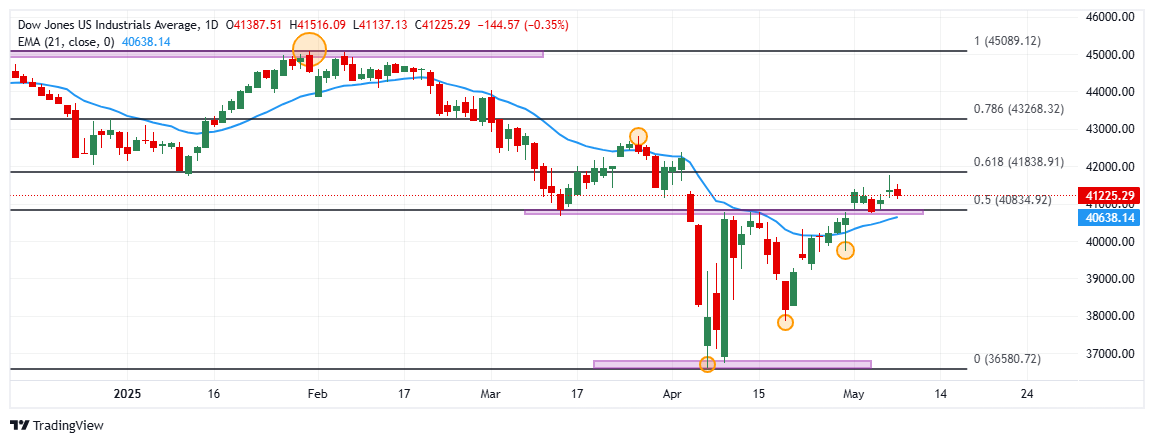- The Dow Jones decreased 0.35% daily, reaching minimum of May 7 at 40,821
- Nasdaq 100 falls 0.09% today, dragged by Crowdstrike Holdings (CRWD).
- The S&P 500 loses 0.06% on Friday, weighed by Akamai Technologies (AKAM)
- Donald Trump commented that he will maintain tariffs despite reaching trade agreements.
The Dow Jones marked maximum of the day in 41,516, finding aggressive vendors that dragged the index to a daily minimum in 41,117.
The Dow Jones industrial average began operating in 41,387, while the Nasdaq 100 technological index began negotiations in 20,089. The S&P 500 opened in 5,669, operating in negative terrain on the last day of the week.
Amgen and Merck & Company drag Dow Jones to loss zone
The Dow Jones index falls 0.35% today, reaching a minimum of the day in 41,137.
Amgen’s shares (AMGN) have a loss of 2.28% today, visiting minimal not seen since January 14 at 265.66 $, signing its second consecutive day down.
Merck & Company titles (MRK) go back 2.16% daily, reaching minimum of February 28, 2022 in $ 75.82, spinning two consecutive days with losses.
In this context, Dow Jones slides to 144 points, ending with two consecutive days upwards, currently quoting over 41,225.
Crowdstrikeholdings and Regeneron Pharmaceuticals lead the losses in Nasdaq 100
The Nasdaq 100 technological index loses 0.06% daily, consolidating within the operational range of the previous session at 20,050.
Crowdstrikeholdings (CRWD) values fall 4.35% on Friday, today visiting April 24 at $ 404.63, leading losses in Nasdaq 100.
In the same tune, the Ageneron Pharmaceuticals (REGN) shares, 3.63% daily, staying within the operational range of the previous session at 527.78 $, signing its second consecutive day down.
The Nasdaq 100 falls 11 points today, reaching a minimum of the session at 19,978, quoting on negative terrain in tune with the main stock market indices.
The S&P 500 is quoted with marginal losses on the last day of the week
The Akamai Technologies (AKAM) shares lose 10.76% in the day, reaching minimal not seen since April 24 at $ 76.20.
Akam published its earnings report today, obtaining $ 1.02 billion compared to 1.01 billion dollars, as well as a profit rate of $ 1.70, compared to the $ 1,569 planned by the consensus.
The S&P 500 loses 5 points today, presenting a marginal loss of 0.09%, quoting when writing about 5,656, consolidating within the operational range of the previous session.
The president of the United States, Donald Trump, said that universal tariffs of 10% on imports will be maintained, even after reaching commercial agreements with other countries. However, he added that there would be exceptions if its commercial partners offer advantageous conditions.
Technical Analysis of Dow Jones
The Dow Jones 100 formed a short -term support given by the minimum of April 21 in 37,856. The following important support is observed in 36,614, minimum of April 7. Upwards, the key resistance is 45,068, a pivot point of January 31.
Dow Jones daily graphics

Dow Jones Faqs
The Dow Jones Industrial Avenge, one of the oldest stock market indexes in the world, consists of the 30 most negotiated values in the United States. The index is weighted by the price instead of capitalization. It is calculated by adding the prices of the values that compose it and dividing them by a factor, currently 0.152. The index was founded by Charles Dow, also founder of the Wall Street Journal. In recent years it has been criticized for not being sufficiently representative, since it only follows 30 companies, unlike broader rates such as S&P 500.
There are many factors that promote the Dow Jones Industrial Average (DJIA) index. The main one is the added performance of the companies that compose it, revealed in the quarterly reports of business benefits. The American and world macroeconomic data also contribute, since they influence investor confidence. The level of interest rates, set by the Federal Reserve (FED), also influences the DJia, since it affects the cost of credit, on which many companies depend largely. Therefore, inflation can be a determining factor, as well as other parameters that influence the decisions of the Federal Reserve.
Dow’s theory is a method to identify the main trend of the stock market developed by Charles Dow. A key step is to compare the direction of the Dow Jones Industrial Avenge (DJIA) and the Dow Jones Transportation Average (DJTA) and just follow the trends in which both move in the same direction. The volume is a confirmation criterion. The theory uses elements of maximum and minimum analysis. Dow’s theory raises three phases of the trend: accumulation, when intelligent money begins to buy or sell; Public participation, when the general public joins the trend; and distribution, when intelligent money abandons the trend.
There are several ways to operate with the DJ. One of them is to use ETF that allow investors to negotiate the DJ as a single value, instead of having to buy shares of the 30 companies that compose it. An outstanding example is the SPDR Dow Jones Industrial Avenge ETF (day). Future contracts on the DJ allow the specular operators about the future value of the index and the options provide the right, but not the obligation, to buy or sell the index at a predetermined price in the future. Investment funds allow investors to buy a part of a diversified portfolio of DJ values, which provides exposure to global index.
Source: Fx Street
I am Joshua Winder, a senior-level journalist and editor at World Stock Market. I specialize in covering news related to the stock market and economic trends. With more than 8 years of experience in this field, I have become an expert in financial reporting.







